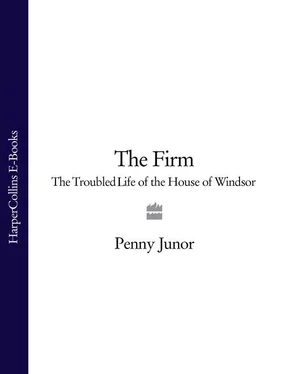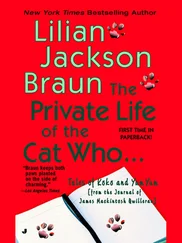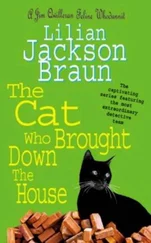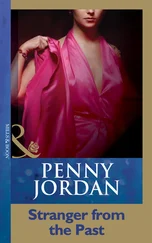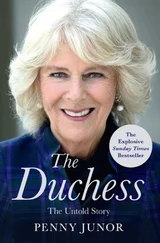The crowds were contained behind barriers on either side of the street, as with all such visits, leaving the middle clear for the royal party. Diana and Charles took one side each and there were audible groans of disappointment when people realized that they would get Charles rather than Diana. It was no secret that the enthusiasm and the flowers were all for Diana. ‘Do you want me to give those to her?’ Charles said time and time again as people held posies aloft and looked longingly in her direction. ‘I seem to do nothing but collect flowers these days. I know my role.’ He was laughing, and I have no doubt at all that at that time he was terribly proud of his wife and pleased that people liked her, but as time went by and the pattern repeated itself endlessly, his laughter began to ring hollow.
He was not used to sharing the limelight. He had been the centre of attention wherever he went for thirty-two years – and he was being eclipsed by his wife. His work, his speeches, his visits, everything was being overshadowed by Diana; and through no fault of her own. Later it became a deliberate ploy but at that time she was as surprised as anyone by the mania which gripped the nation. Every day some trivial story provided an excuse to have her on the front page of the newspapers. Charles began to lose heart – and who can blame him? There were so many serious and important issues that needed airing but no one seemed to be listening. All they seemed to care about was Diana’s wardrobe. Diana wore pearl chokers that had scarcely been seen since the nineteenth century and suddenly the shops were full of them. She wore culottes on honeymoon and culottes returned to fashion; high necks and they too flooded the market; and her hairstyle was copied in every high-street salon.
Diana’s popularity was phenomenal but it was not the first time that the nation, or indeed the world, had fallen in love with a beautiful royal princess. The Queen is good-looking now in her seventies – as the young Princess Elizabeth she was breathtakingly pretty. She was not tall and rangy like Diana, and her style was quite different, but she had flawless skin, a good figure and the most radiant smile that won hearts as surely as Diana’s did thirty years later. When the mania over Diana was at its height, one of the Queen’s courtiers said, ‘Ma’am, you will never have seen anything like the publicity Charles and Diana are having.’ ‘You were not around,’ she said witheringly, ‘when Margaret and I were having our future husbands talent-spotted for us. In comparison with the width and breadth and depth of the media in those days, it was just as great if not greater. Daily we were being lined up with some new suitor.’ ‘I couldn’t argue,’ he says. People turned out in their thousands not just in Britain but in the countries she visited all over the world to see Princess Elizabeth and cheer her. Monarchy at that time was revered in a way that the youth of today would find incomprehensible.
Her marriage in November 1947 to the Greek Prince Philip, a tall, blond, handsome naval officer, riveted a nation still in the grip of post-war austerity. It was broadcast on the radio in forty-two countries, millions of people sat glued to their sets, thousands lined the route to Westminster Abbey, dozens camped out in the Mall overnight to be sure of their place, and all over the country there were parties, fireworks and celebrations.
At her coronation six years later the traffic jams in London, into which people had begun flooding ten days before the ceremony, were so bad that the police had to ban all but priority and public service vehicles from entering an area within a two-mile radius of Westminster. ‘Never has there been such excitement,’ wrote Jock Colville, her Private Secretary, ‘never has a monarch received such adulation.’ Sir Charles Petrie, the monarchist historian, concurred. ‘For the first few years of her reign,’ he wrote in 1961, ‘she was the subject of adulation unparalleled since the days of Louis XIV.’
The excitement of the coronation went on for weeks, and the adulation for perhaps the first ten years of her reign, but as the Queen’s biographer Ben Pimlott observed, ‘Popularity is not normally seen as a reason for self-appraisal – it is more likely to encourage a belief that the existing formula is a successful one … Hence in the mid-1950s, on the back of the fragile post-war recovery, and cosseted by governments that were happy to bask in the reflected glory, the monarchy wasted its most bountiful years – taking what it was given in mindless admiration as its due.’
Elizabeth II was never going to be a radical monarch in any event. Her personality didn’t allow it. She was too shy and introverted, too conservative, too responsible to risk rocking the boat. She stepped into King George VI’s shoes when she was just twenty-five, a young mother with two small children and a passive acceptance of her destiny but no burning ambition to change either the world or the monarchy. She hero-worshipped her father and he was her role model; he was not the most charismatic of men, he was shy and had struggled with a stammer all his life, but he cared about people, about the less privileged, and with Queen Elizabeth beside him he had been an exemplary monarch, and perfect for restoring confidence in the monarchy after the trauma of his brother’s abdication. He was also perfect for the period when Britons pulled together against a common enemy; and in identifying himself so completely with their difficulties helped to stimulate a spirit of social solidarity which his daughter inherited. In the immediate aftermath of her coronation, there was no obvious need for change; and so along with his quiet, dutiful manner, she also inherited his courtiers, his palace and his way of working.
The young Elizabeth’s personality was both her handicap and her saviour. It may have prevented her from moving monarchy forward in those early years, but it also prevented her from believing her own publicity. It would have been very easy to let the adulation go to her head; to take it personally, as Diana, thirty years later did. The Queen never fell into that trap. She has always managed to differentiate between the public persona and the private one. In public she is Queen, Head of State, Supreme Governor of the Church of England, an office that she has the privilege to hold by virtue of her birth. And when people cheer and shout and proffer gifts and flowers, she knows they are only doing that because of the office she holds. If she were plain Mrs Windsor no one would turn a hair as she walked down the street. The face she presents to the outside world is the public face. Privately she is a wife, mother and rather doting grandmother, with a passion for dogs, horses, the countryside and traditional country sports.
With Diana there was no such demarcation; there had been no long preparation for a public role in life. Since the age of ten the Queen had been aware of the future that lay ahead and her education was tailored to that end. Diana started seeing the Prince of Wales in the summer of 1980; she was young and unsophisticated. She had come away from school with few qualifications, she had been briefly to finishing school in Switzerland, she had danced a bit, been a nanny for a while and was working as an assistant in a nursery school when she was suddenly, and unceremoniously thrust into the limelight. Less than a year later, on 29 July, just a month after her twentieth birthday, she had become the Princess of Wales, one of the most famous faces in the world. The Queen was used to the cameras, used to the publicity, used to being the centre of attention. She was a steady character from a secure and loving background. Diana was not. Aristocratic blood may have coursed through her veins but she was vulnerable and needy; she came from a broken home, with all the resultant insecurities. She had been parted from her mother when she was six years old and was desperate to be loved.
Читать дальше
